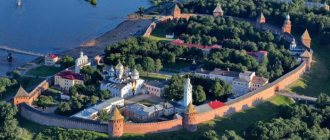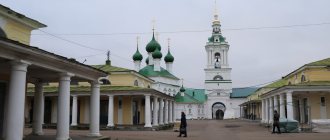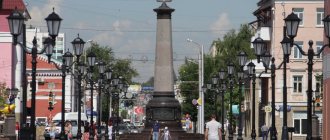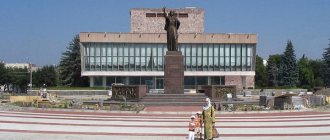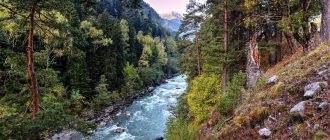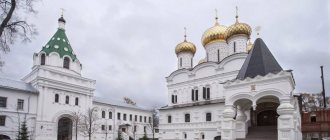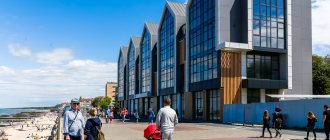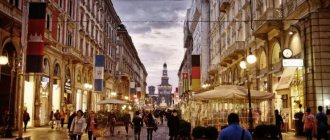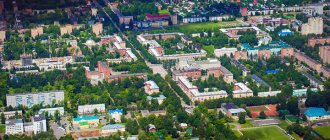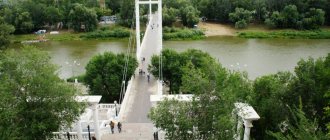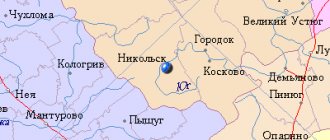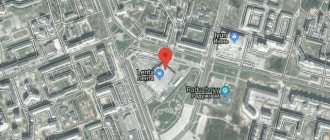Tourists come to Zelenogradsk to see interesting sights, touch history, get acquainted with foreign culture on Russian soil and improve their health at one of the best resorts on the Baltic Sea coast. In the middle of the 20th century, Prussian Kranz became Soviet Zelenogradsk, and today it is a city in the Kaliningrad region, located at the junction of two cultures. Its story is similar to an adventure novel; it brings together amazing characters - sailors, amber traders, Vikings and Teutons.
Zelenogradsk city (Russia)
Zelenogradsk is a resort town on the Baltic Sea in the Kaliningrad region. Until 1946, it was called Kranz and belonged to Germany, being one of the most popular resorts in the German Baltic. Zelenogradsk is a charming green city with a German character, a picturesque coastline and endless sandy beaches.
In Zelenogradsk you can see many old German mansions, built mainly in the style of German Art Nouveau or Art Nouveau architecture. Its modern historical center was formed in the late 19th and early 20th centuries and was practically not damaged during the Second World War. Zelenogradsk still remains a very popular resort and an excellent place for a quiet family holiday.
Murarium Cat Museum
Address: st. Saratovskaya, 2A. Website: https://murarium.ru. Opening hours: daily from 11 to 19 hours. Ticket price: 280 rubles, children and pensioners - 230 rubles.
On the territory of the former water tower there is a cat museum. Its exhibition includes a private art collection of the cat family. There are about 4,500 exhibits made from different materials: wool, wood, metal, glass.
Spectators can see cats from Japan, Egypt, and Polynesia. Animals are presented not only in the form of figurines, they are depicted on badges, paintings, souvenirs, and chocolate bars. There is nothing like it anywhere else in the country.
Guides: Russia
Moscow
Saint Petersburg
May be interesting: Other cities in Russia
Monument to Adam Mickiewicz
In agreement with the city residents, a monument to Adam Mickiewicz, a poet who had a great influence on the development of literature in Belarus, Poland and Lithuania in the 19th century, was erected near the Literary Trail of the city garden. Mickiewicz was traveling to St. Petersburg and on the way stopped in Kranz for several days in the fall of 1824.
The idea of installing the monument was proposed by local historians, and the sculpture was made by Valery Kovalev, a resident of Kaliningrad. Local entrepreneurs financed the work, and the regional department of culture also allocated money.
Geography and climate
Zelenogradsk is located 30 km north of Kaliningrad on the shores of the Baltic Sea. The city is located on the northern shore of the Kaliningrad (Zemland) Peninsula, where the Curonian Spit begins. The climate here is temperate maritime. It is characterized by warm, often rainy summers and cool winters with slight frosts.
Streets of Zelenogradsk
House of Angels
Address: st. Pogranichnaya, 12a Website: https://homeofangels.ru Ticket price: 200 rubles, 120 rubles. — children and pensioners, 50 rubles. - disabled people. Opening hours: daily from 11.00 to 19.00.
The House of Angels is another unusual museum in Zelenogradsk. Here you will find a collection of angels: jewelry with angels, objects decorated with angels, angelic attributes (wings, trumpets) and other angelic items.
Here you can take a photo against the backdrop of large white wings. Angel lovers and children will like it. Located next to St. Adalbert's Church. Angel donors receive free admission to the museum.
Story
In the early Middle Ages, there was a Prussian settlement in the vicinity of Zelenogradsk. In the 9th - 10th centuries, a Viking settlement was founded here. It is believed that Kranz (the German name for Zelenogradsk) was founded in 1252 as a village of Prussian fishermen. At the end of the 13th century, a small Crusader castle was built here and a tavern was founded on the way from Königsberg to Klaipeda.
Zelenogradsk
In 1816 Kranz became a seaside resort. A few decades later the city received the status of a royal resort and by the end of the 19th century it was one of the most popular holiday destinations in Germany. On February 4, 1945, Kranz was occupied by Soviet troops and in 1946 it was renamed Zelenogradsk.
Pump room Queen Louise
Address: Friendship Alley
On the territory of Zelenogradsk there are not only old sights, interesting places still appear today. Thanks to funding from a local philanthropist, a place has recently opened where you can try mineral water, which contains many beneficial substances. Mineral water "Zelenogradskaya", which you can get here for free and take with you, is extracted from a depth of more than 200 meters.
The pump room is named after the beautiful Queen Louise. She visited Kranz at the beginning of the 19th century, hiding from Napoleon's troops.
Attractions
Promenade
Promenade is one of the most popular places in Zelenogradsk. This is a wide promenade that stretches along sandy beaches and is slightly elevated above sea level. Here you can see several interesting sculptures, breathe in plenty of Baltic air and drink mineral water in the Queen Louise pump room, built in 2006 by a philanthropist. The pump room is a brick tent. The pump room also has a picturesque pier that cuts into the sea and from where you can admire beautiful sunsets.
Not far from the pump room is the town hall of the old Kranz - a neat building in the German Art Nouveau style, built at the beginning of the 20th century.
Kurortny Prospekt
Kurortny Prospekt is a charming pedestrian street that has largely preserved the architecture and charm of the old Kranz. Several magnificent ancient buildings have been preserved here.
Former post office
The former post office is a beautiful brick building in the neo-Gothic style, built in the early 20th century.
Kurhaus
The Kurhaus was once Kranz's main hotel and was built in the first half of the 19th century. This charming half-timbered building has now been restored and operates as a private hotel.
Water tower
The water tower is one of the most famous landmarks of Zelenogradsk. It was built at the beginning of the 20th century in Art Nouveau style and was used until 1946. Now within its walls there is a Murarium - a museum dedicated to cats.
There are a lot of cats in Zelenogradsk, which have literally become one of the symbols of the city and part of the city culture.
Adalbert's Church (now the Transfiguration Cathedral)
Adalbert's Church (now the Transfiguration Cathedral) is a neo-Gothic red brick church with an impressive 42-meter tower, built in the late 19th century. During Soviet times, the church was closed. In 2007, the building was consecrated as an Orthodox cathedral.
St. Andrew's Church
The Church of St. Andrew is another Catholic church, rebuilt into an Orthodox church. The church building was built at the beginning of the 20th century in the neo-Gothic style and was used as a warehouse during Soviet times.
Max Krell Villa
Villa Max Krell is a historic building from the early 20th century, built by a famous German lawyer. It is an interesting combination of traditional Russian style and German Gothic. Nowadays there is a local history museum here.
Curonian Spit
The Curonian Spit is a unique natural site that is included in the list of World Heritage Sites. It is a long strip of sand with real dunes, stretching from Zelenogradsk to Klaipeda, Lithuania.
Water tower
Address: Saratovskaya st., 2A
On the territory of the former Kranz there is a water tower 40 meters high, erected at the beginning of the 20th century. For a long time it was used to organize the city water supply network. In the mid-20th century, the Zelenogradsk landmark building was closed due to changes in the water supply system, and in 1990 it was reconstructed.
Today the tower is used as an observation deck; you can get to it by taking the elevator to the top. From here you can clearly see the city.
Parks
City Park and Tortilin Pond
On the same Moskovskaya street, not far from the Promenade, a central city park has been opened, where residents and guests bring their children. The main attractions of the park are hundred-year-old trees and the Tortilin pond, on which wooden water lilies “bloomed” in the form of a bridge.
Tortilina Pond. The kids will love it here!
Indy Park. Laser tag
A 5-minute walk from the city park, closer to the sea, there is a large open-air playground. There are hundreds of entertainment options for children aged 5–13 years old, and a cozy cafe with a snack for parents.
Queen Louise Square
The city of Zelenogradsk, like Sovetsk, loves Queen Louise. Here the pump room is named after her, and the square, and the hotel, and there is a bust of her. Queen Louise was an iconic figure for the Germans. By the way, she is the mother of Princess Charlotte, the wife of Russian Emperor Nicholas I.
The square, named after Queen Louise, was laid out in Zelenogradsk at the beginning of the 21st century. According to legend, it was here that the ruler of Prussia, Frederick William IV, planted a tree in honor of Queen Louise, his mother. This happened in 1843, when he arrived in Kranz.
In 2007, a royal bust complemented the park. It was donated to the city by the leadership of the German city of Bad Doberan. The bust is made of bronze and is a copy of a work made by the German sculptor Rauch in the 19th century. Today it is in the National Gallery in Berlin, and its copy is in the city park of Zelenogradsk.
